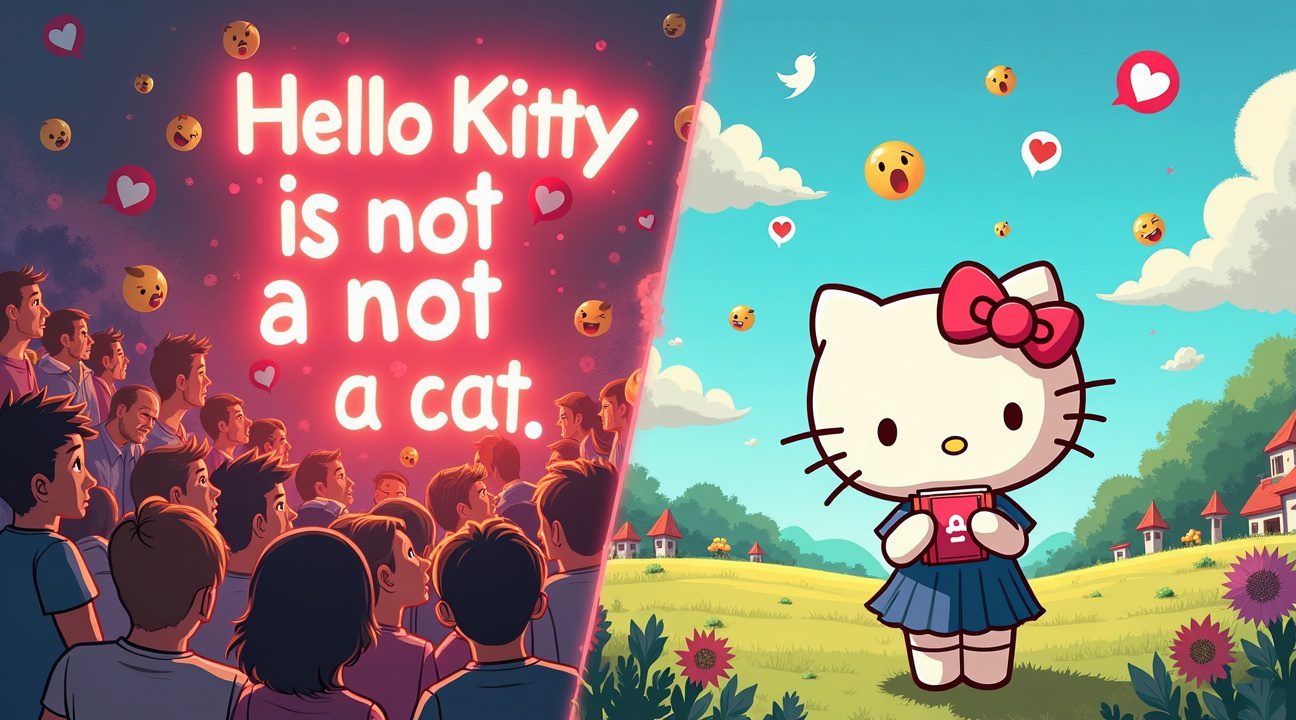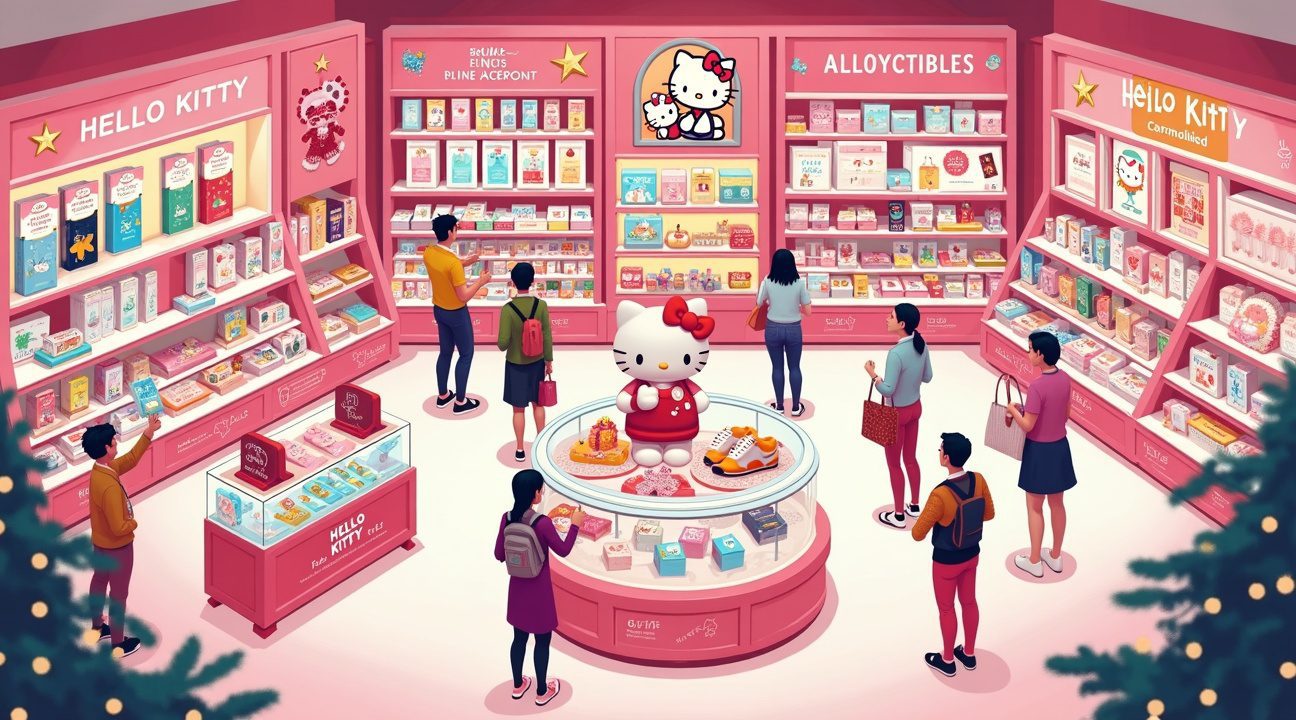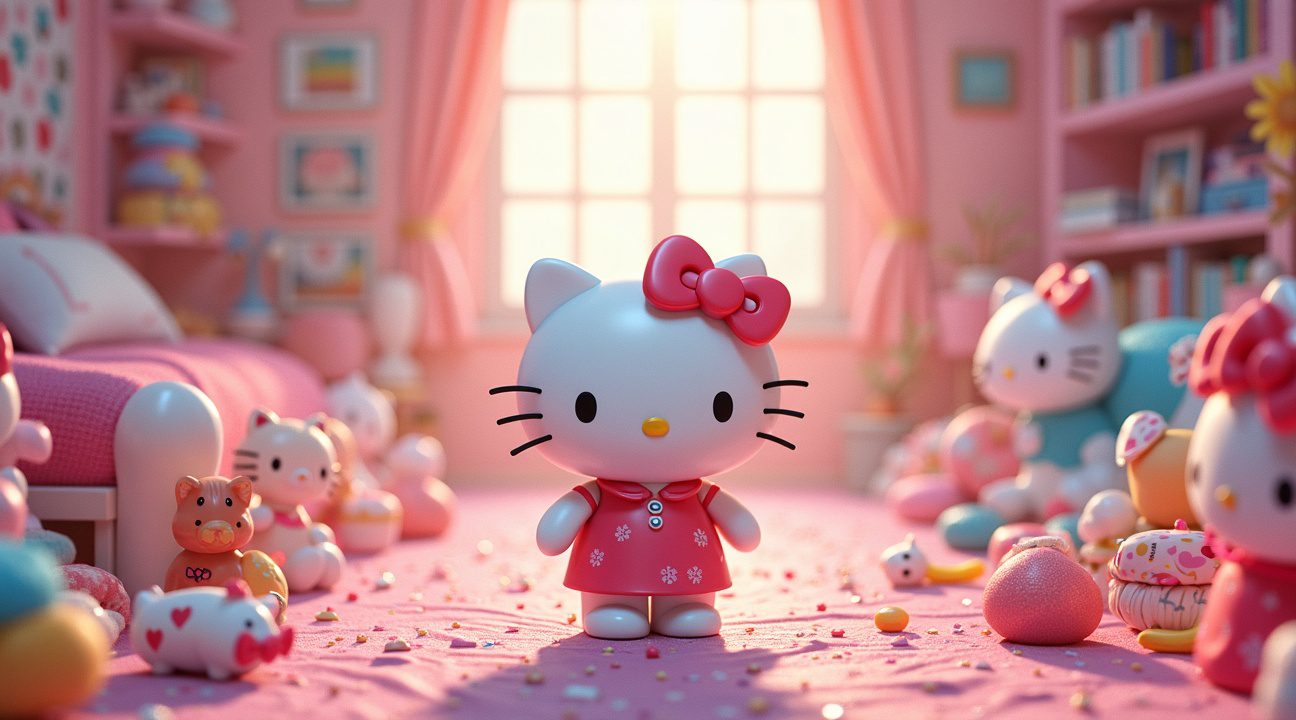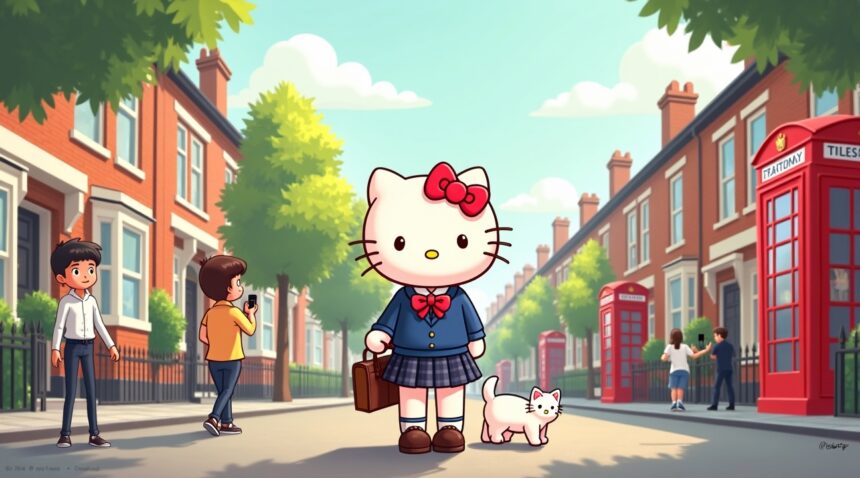Recent revelations from Sanrio have shocked fans worldwide by confirming that Hello Kitty is not actually a cat, but rather a British schoolgirl named Kitty White.
Key Takeaways
- Hello Kitty is officially described by Sanrio as a British schoolgirl named Kitty White, not a cat, despite her feline-inspired appearance with whiskers and pointed ears.
- The character exhibits human behaviors including walking upright, owning pets (like her own cat named Charmmy Kitty), and attending school.
- Social media has exploded with disbelief, generating viral hashtags such as #HelloKittyIsNotACat as fans express shock over this long-standing misconception.
- Hello Kitty remains the second-highest grossing media franchise globally, with Sanrio reporting an 82% surge in net profits during 2024’s 50th anniversary celebrations.
- The character’s cultural legacy spans generations, featuring over 3.5 million TikTok followers and collaborations with luxury designers and major retailers alike.
Kitty White: A Character Hidden in Plain Sight
Sanrio’s recent confirmation has left millions of fans reexamining what they thought they knew about Hello Kitty. The Japanese company made it clear that their beloved icon is a British schoolgirl, not a feline. This seemingly small clarification actually reshapes how people perceive the character’s design and behavior.
Once fans look closely, Hello Kitty’s human behaviors become undeniable. She walks upright, goes to school, has a twin sister, and even owns a pet cat named Charmmy Kitty. If she herself were a cat, this would be an odd narrative choice. These elements have always been a part of her official bio—hidden in plain sight for decades.
Viral Reactions Across the Web
Social media platforms lit up with reactions following the news. Twitter users shared memes, while TikTok creators published videos dissecting the revelation—many receiving millions of views. While some fans felt misled, Sanrio insists that they never intended to deceive anyone and have long made the character’s true identity publicly available.
Financial Success Amid Controversy
The announcement comes during a banner year for Hello Kitty. In 2024, the brand celebrated its 50th anniversary. During this time, Sanrio reported an impressive 82% increase in net profits, proof of the character’s enduring financial power. The Hello Kitty franchise continues to produce billions in revenue through merchandise, licensing, and strategic partnerships worldwide.
Why Hello Kitty Endures
Hello Kitty’s staying power can be attributed to her universal appeal. Her blank expression lets viewers assign any mood they choose, making her emotionally accessible across cultures. It’s a strategy that’s worked brilliantly since her 1974 debut.
More than just a toy, Hello Kitty is woven into fashion and lifestyle. She has appeared in high-end collections from brands like Balenciaga, while mainstream stores sell kitchenware and casualwear adorned with her face. Her versatility as a brand icon is unparalleled.
Strategic Brand Evolution
Sanrio has skillfully marketed Hello Kitty not just as a character, but as a symbol of friendship and kindness. The company’s ability to keep the brand fresh while sticking to core values has enabled it to appeal to new audiences while retaining loyal fans.
Unexpected Upside from Viral Attention
Despite initial shock from fans, the viral debate may actually work in Sanrio’s favor. Media buzz often leads to higher merchandise sales and increased brand engagement. Sanrio’s stock price shows no negative impact, indicating investors see the revelation as a growth opportunity rather than a liability.
A Philosophy Behind the Character
Understanding Hello Kitty as Kitty White reveals Sanrio’s broader character development philosophy—melding animal traits with human stories to create engaging, cross-cultural personalities. This method enriches the universe of Sanrio characters and expands narrative possibilities.
The Power of Digital Storytelling
Platforms like TikTok have helped newer generations learn about Hello Kitty’s lore. Videos explaining her backstory have quickly amassed millions of views, showing how digital tools can inform and educate fans about brand history in ways that weren’t possible decades ago.
Dedicated Fans vs. Casual Viewers
Seasoned fans, who’ve known about Kitty White’s human identity for years, often find humor in the public’s surprise. Some express frustration that so many consumers were unaware of basic character facts, reinforcing how shallow engagement can lead to widespread misconceptions.
Sanrio’s layered universe rewards deeper dives. Hello Kitty’s relationships—with family, friends, and pets—compose a vibrant world rich for storytelling. This nuance separates robust character brands from simple mascots.
The Importance of Narrative Accuracy
The Hello Kitty story reflects a broader issue in modern pop culture: how characters are interpreted more through visuals and memes than confirmed narratives. Rapid online sharing can distort stories just as easily as it spreads correct information. Brands must now tailor communication strategies for fast-paced, multi-platform contexts.
The Significance of Hello Kitty in 2024
The character’s continued success proves the power of intentional design and responsive brand management. Though the revelation of her identity sparked short-term confusion, it has ultimately reinforced her cultural resonance. Hello Kitty, or rather Kitty White, continues to engage generations and inspire passionate dialogue worldwide.
The Shocking Truth: Hello Kitty Is Actually a British Schoolgirl Named Kitty White
I’ve discovered something that might completely change how you view one of the most iconic characters in pop culture. Hello Kitty isn’t actually a cat, despite what her appearance suggests. According to official statements from Sanrio, the company behind the beloved character, Hello Kitty is officially described as a British schoolgirl named Kitty White.
This revelation came to light when Hello Kitty scholar Christine R. Yano quoted Sanrio’s explicit statement: “Hello Kitty is not a cat… She is a little girl. She is a friend. But she is not a cat.” This official clarification shocked fans worldwide who had spent decades assuming her feline identity based on her cat-like features.
Evidence of Her Human Identity
Several compelling details support Hello Kitty’s human classification rather than her perceived feline nature. Kitty White displays distinctly human behaviors and characteristics that cats simply don’t possess:
- She walks upright on two legs like a human child
- She owns pets, including a cat named Charmmy Kitty
- She has a complete family structure with parents and siblings
- She’s portrayed sitting at desks and engaging in school activities
- She participates in human social activities and relationships
The fact that Hello Kitty has her own pet cat serves as perhaps the strongest evidence against her being a cat herself. This detail alone should have tipped off fans years ago, yet somehow fans shocked by celebrity revelations often overlook obvious clues.
Her Official Backstory
Kitty White’s character development includes a comprehensive human backstory that Sanrio has maintained for decades. She was born in the suburbs of London, England, with an official birthday of November 1. Her family consists of parents named George and Mary White, plus a twin sister called Mimmy. This detailed family structure mirrors typical human family dynamics rather than animal relationships.
The character’s British origins explain her proper name and refined personality traits that have made her appealing to audiences worldwide. Her schoolgirl status aligns with her frequent appearances in educational settings and her role as a friend to children rather than a pet.
This character revelation highlights how Hello Kitty’s human-like features were intentionally designed from the beginning, yet somehow contributed to long-standing identity misconceptions among fans. The confusion likely stems from her cat-like ears and whiskers, which Sanrio designed to make her more appealing while maintaining her human essence underneath the feline-inspired exterior.
Why Fans Are Completely Stunned by This Revelation
The discovery that Hello Kitty isn’t actually a cat has sent shockwaves through generations of fans who’ve grown up believing otherwise. For decades, people have looked at her distinctive whiskers, perfectly round button nose, and pointed ears and naturally concluded she must be a feline character. This assumption seemed so obvious that questioning her species never crossed most fans’ minds.
Social Media Erupts with Disbelief
The revelation that Hello Kitty is actually a British schoolgirl named Kitty White has triggered an unprecedented wave of reactions across social platforms. TikTok users have been particularly vocal about their surprise, with the platform showing Hello Kitty’s massive reach of over 3.5 million followers and an impressive 27.9 million likes. Content creators have flooded feeds with reaction videos, expressing genuine shock and confusion about this character detail that apparently existed all along.
Hashtags like #HelloKittyIsNotACat have gained significant traction, with users sharing their bewilderment and creating countless memes that capture the collective “mind-blown” moment. Many fans have admitted feeling slightly betrayed, as if they’ve been living a lie for years. The reactions range from humorous disbelief to genuine confusion about how they missed such a fundamental detail about one of pop culture’s most recognizable characters.
What makes this revelation particularly jarring is how naturally people accepted Hello Kitty’s cat identity without question. Her design elements – those iconic whiskers, the rounded facial features, and especially those triangular ears – create such a convincing feline appearance that alternative interpretations seemed impossible. Even her name reinforces the cat connection, making the schoolgirl identity feel like a complete departure from everything fans thought they knew.
The mainstream media’s long-standing treatment of Hello Kitty as a cat character has only reinforced this misconception over the years. Articles, merchandise descriptions, and casual references consistently positioned her within feline categories, creating a cultural understanding that went largely unchallenged. This widespread acceptance across media outlets demonstrates how easily collective assumptions can become accepted facts.
Many longtime collectors and enthusiasts have expressed feeling embarrassed about their surprise, questioning how they never encountered this information despite years of engagement with the character. Some have gone back through official materials and discovered subtle hints they previously overlooked, while others remain skeptical about the authenticity of this claim.
The intensity of fan reactions also highlights Hello Kitty’s deep cultural penetration and emotional connection with audiences worldwide. When a character becomes so embedded in popular consciousness, any challenge to established perceptions can feel deeply unsettling. Fans have invested emotional energy and formed attachments based on their understanding of her as a cat, making this identity shift feel like a fundamental disruption to their relationship with the character.
Fans shocked by unexpected revelations about beloved characters isn’t entirely uncommon in pop culture, but the scale of surprise surrounding Hello Kitty’s true identity has been particularly remarkable. The combination of her massive global fanbase and the seemingly obvious nature of her presumed cat identity has created perfect conditions for viral bewilderment.
This situation has also sparked broader conversations about character design and how visual cues can lead audiences to make assumptions that creators never intended. Hello Kitty’s case serves as a fascinating example of how design elements can communicate one thing while the official story tells another, creating space for widespread misunderstanding that persists for decades.
The ongoing discussions demonstrate how deeply ingrained Hello Kitty’s cat identity had become in popular culture, making her actual backstory as a British schoolgirl feel like a complete reimagining rather than a clarification of existing facts.

Hello Kitty’s Incredible Brand Power Reaches Record Heights
Hello Kitty stands as the second-highest grossing media franchise worldwide, demonstrating the character’s extraordinary commercial reach despite ongoing confusion about her true identity. While fans debate whether she’s actually a cat, Sanrio continues to capitalize on the character’s universal appeal through strategic brand expansion and anniversary celebrations.
Financial Performance Reaches New Milestones
Sanrio experienced remarkable financial growth in 2024, driven largely by celebrations marking Hello Kitty’s 50th anniversary. The company reported an impressive 82% jump in net profits during the first half of 2024, reflecting the enduring strength of the Hello Kitty brand across global markets.
The second quarter alone delivered exceptional results that exceeded industry expectations:
- Net sales increased 43% to reach 62.8 billion yen
- Operating profit surged by 77% to hit 23.5 billion yen
- Sales performance in the Americas showed a remarkable 141% year-over-year increase
- International expansion contributed significantly to overall revenue growth
These figures underscore Hello Kitty’s immense global appeal and demonstrate how the character transcends cultural boundaries. The financial success validates Sanrio’s long-term strategy of positioning Hello Kitty as more than just a cartoon character – she’s become a lifestyle brand that resonates with consumers across generations.
The Americas market performance particularly highlights Hello Kitty’s growing influence in Western markets. This surge reflects increased brand awareness and successful collaborations with major retailers and fashion brands. Companies often underestimate the power of character licensing, but Hello Kitty’s performance proves that well-managed intellectual property can generate substantial revenue streams.
Anniversary celebrations played a crucial role in driving these record-breaking numbers. Limited edition merchandise, special collaborations, and nostalgic marketing campaigns tapped into both longtime fans and new audiences discovering the character. The strategy demonstrates how heritage brands can leverage milestone moments to reinvigorate consumer interest and drive sales growth.
While some might find it surprising that entertainment industry surprises continue to captivate audiences, Hello Kitty’s success shows that character-driven brands maintain their power regardless of technical classifications. Whether she’s officially a cat or a little girl doesn’t diminish the character’s ability to generate billions in revenue and maintain cultural relevance across decades.
Top-Selling Products and High-Profile Collaborations Drive Success
Despite the shocking revelation that Hello Kitty isn’t actually a cat, the character’s commercial success continues to soar through strategic product releases and partnerships. I’ve observed that merchandise sales maintain consistent strength throughout the year, with December consistently delivering the highest performance numbers across all product categories.
Best-Performing Product Categories Show Clear Consumer Preferences
The data reveals fascinating insights about what drives Hello Kitty’s commercial empire. Stationery products lead the pack with impressive search volume peaks reaching 86, while apparel follows closely behind with spikes hitting 50. These numbers demonstrate that consumers gravitate toward practical items they can incorporate into daily life, regardless of whether they view Hello Kitty as a cat or a little girl.
Collectibles represent another powerhouse category, accounting for 30% of overall sales growth. Limited-edition plush toys consistently outperform standard releases, with items like the Superbitz Twin Sisters set becoming instant hits among collectors. Seasonal holiday-themed products also drive significant revenue spikes, particularly during winter months when gift-giving traditions boost demand.
The pricing strategy remains accessible to most consumers, with average product costs typically falling between $10 and $20. This $14 average price point strikes an effective balance between affordability and perceived value, allowing fans to build collections without breaking budgets. Celebrity endorsements and pop culture connections have further amplified these sales figures.
High-profile collaborations have transformed Hello Kitty from a simple character into a legitimate fashion statement. Luxury partnerships with Adidas, Balenciaga, and Anteprima have elevated the brand’s status beyond traditional toy markets. These collaborations introduce Hello Kitty to sophisticated audiences who might otherwise dismiss cartoon characters as childish.
Cross-brand partnerships extend beyond fashion into entertainment territories. The Sonic the Hedgehog collaboration exemplifies how Hello Kitty transcends its origins to connect with diverse fandoms. Streaming platforms have also embraced the character, recognizing its broad appeal across age demographics.
Exclusives and seasonal drops create urgency that drives purchasing decisions. Limited availability triggers collector mentality, even among casual fans who suddenly feel compelled to own rare items. Animation partnerships continue expanding these opportunities, introducing Hello Kitty to new audiences through unexpected collaborations.
The collectibles market particularly benefits from this scarcity model. Special editions and anniversary releases command premium prices while maintaining strong demand. Award-winning animated properties often seek Hello Kitty partnerships, recognizing the character’s proven ability to drive merchandise sales.
Retail partnerships amplify these successes through strategic placement and marketing support. Major retailers understand that Hello Kitty products generate consistent foot traffic and impulse purchases. The character’s recognizable design makes products instantly identifiable, even to consumers who aren’t familiar with recent storylines or character developments.
Digital platforms have opened new revenue streams through virtual collectibles and mobile game partnerships. Streaming services increasingly recognize Hello Kitty’s value as family-friendly content that appeals to multiple generations simultaneously.
International expansion continues driving growth, with products adapted for regional preferences while maintaining core brand identity. Different markets show varying preferences for specific product categories, but the overall commercial framework remains consistent across territories.
The revelation about Hello Kitty’s true identity as a little girl rather than a cat hasn’t dampened commercial enthusiasm. Instead, it has generated renewed interest and media coverage that translates into increased sales. Fan reactions to unexpected revelations often create viral moments that benefit overall brand visibility.
Product innovation remains crucial for sustaining this success. New categories emerge regularly, from home décor to technology accessories, ensuring Hello Kitty stays relevant across changing consumer preferences. The brand’s ability to adapt while maintaining its core visual identity continues driving both new customer acquisition and existing fan loyalty.

Hello Kitty’s Cultural Impact Spans Multiple Generations
Hello Kitty’s cultural significance has grown far beyond her 1974 debut, creating a phenomenon that bridges decades and demographics. I’ve watched this character transcend traditional boundaries to become a true cross-generational icon. Her influence extends from childhood bedrooms to high-fashion runways, proving that great design speaks to universal human emotions regardless of age.
The digital transformation of Hello Kitty’s presence demonstrates how classic characters can adapt to modern platforms. Her TikTok following now exceeds 3.5 million users, showcasing an remarkable ability to connect with Gen Z through carefully crafted digital engagement. This younger audience discovers Hello Kitty through different channels than previous generations, yet the emotional connection remains equally strong. Social media has allowed her to maintain relevance while introducing her aesthetic to millions of new fans worldwide.
Strategic Business Evolution Drives Continued Success
Sanrio’s U.S. operations have experienced a remarkable turnaround, achieving record profits through focused digital marketing strategies and expanded licensing agreements. These strategic branding partnerships have positioned Hello Kitty in unexpected spaces, from luxury collaborations to mainstream retail partnerships. I notice how these business decisions reflect a deeper understanding of consumer behavior across different age groups and cultural backgrounds.
The franchise expertly balances nostalgia marketing with fresh, contemporary approaches that speak to current social values. Hello Kitty promotes inclusivity through her wordless design, allowing people from any background to project their own stories onto her blank expression. This universal appeal has made her a lasting symbol of kawaii culture that continues to influence global fashion trends and social movements.
Her impact on the collectibles market demonstrates the power of character-driven merchandising. Hello Kitty products span from affordable everyday items to limited-edition luxury pieces, creating multiple entry points for fans at different life stages. Entertainment properties often struggle to maintain this kind of sustained commercial success across generations.
The character’s evolution reflects broader changes in how people consume media and express identity. Hello Kitty has become more than merchandise — she’s a form of self-expression that transcends traditional age boundaries. Parents who grew up with Hello Kitty now share her with their children, creating a unique intergenerational bond that few characters achieve.
Fashion designers continue to reference Hello Kitty’s aesthetic in high-end collections, proving her influence extends well beyond children’s products. Her simple design philosophy has inspired countless other characters and brands, yet none have achieved her level of sustained cultural penetration. The recent revelation about her character background only adds to her mystique, generating renewed interest and conversation across social media platforms.
Cross-cultural adoption has made Hello Kitty a global ambassador for Japanese kawaii culture. She’s introduced millions of people to Japanese design principles and cultural values, creating positive associations that extend beyond entertainment. This cultural bridge-building demonstrates how effective character design can promote understanding and appreciation across different societies.
Her legacy as a pop icon remains remarkably strong across multiple platforms and age groups. Streaming services and digital platforms have only amplified her reach, allowing new generations to discover Hello Kitty through various media formats. The character’s ability to adapt to new technologies while maintaining her core appeal speaks to the genius of her original design.
Hello Kitty’s continued relevance proves that authentic emotional connections transcend technological changes and generational shifts. Her influence on the global market for character-driven collectibles has established patterns that other brands still attempt to replicate. The surprise many people feel upon learning she’s not technically a cat only reinforces how deeply embedded she’s become in popular consciousness, creating new conversations and renewed interest in her already impressive cultural legacy.

Sources:
4sgm – Hello Kitty Is Worth More Now Than Ever As She Turns 50
Accio – Is Hello Kitty Trending in 2025? Latest Sales Data & Market Insights
SaleHoo – Hello Kitty Market Trends Forecast 2025
Accio – Hello Kitty Trend 2025: Sales Peaks, Collaborations & Collectibles
Statista – Sanrio’s Product Sales FY 2017-2023
Tokyoscope – The Hello Kitty Comeback: Sanrio’s Three Secrets for US Success


